Like his Robinson Crusoe, released two years earlier, Death in the Garden is a subterfuge film from Luis Buñuel, in which his particular style and political views are subsumed within genre trappings. This is largely an exotic adventure, in the manner of Casablanca or The African Queen, following a mismatched group who bands together to flee revolution in South America. Yet by the time their adventure comes to a pitilessly ironic end, there is no doubt that this is the work of Buñuel.
The movie begins with a miners’ revolt in a small village against the governmental authorities who are threatening to confiscate the miners’ plots. In the ensuing chaos, an older miner and his mute and deaf daughter (Charles Vanel and Michèle Girardon) steal away with a priest (Michel Piccoli), a prostitute (Simone Signoret), and a mercenary (Georges Marchal).
Politically the movie may side with the miners, but once this crew forms and heads into the jungle, Buñuel is more interested in exploring the hypocrisies that exist in every human heart. And so the priest is a fraud, the prostitute is an opportunist, and the miner loses his mind. (There is dreamy moment in which the image of cars circling the Arc de Triomphe in Paris, where the miner hoped to open a restaurant, transitions into a close-up of a still photograph of the very same scene, which the miner then tosses into the campfire.) As for the mercenary and the daughter, well, if he’s spared it’s likely because he’s up front from the start about his intentions, while she’s a handy stand-in for the naïveté and powerlessness of innocence.
If this sounds dreary, be assured that Buñuel brings his usual dark humor and visual wit to the proceedings. On the verge of starvation, these refugees have nevertheless established a sort of solidarity in their suffering. But then they stumble upon a luxury jet that has crashed in the jungle, leaving food, clothing, and jewelry strewn all over the place. They immediately set about re-establishing civilization—Djin, the prostitute, finds a gown and gets done up as if she’s attending a ball—and almost as quickly petty jealousy and selfishness set in. If Crusoe ended with the somewhat puzzling image of Buñuel’s title buffoon firmly reestablishing his bourgeois authority, Death in the Garden concludes with a more subversive poetic image: two figures blithely paddling across a South American lake as if they were in a Venetian gondola, when in fact a literal and spiritual wilderness surrounds them.



